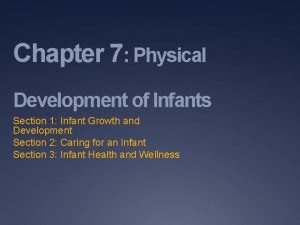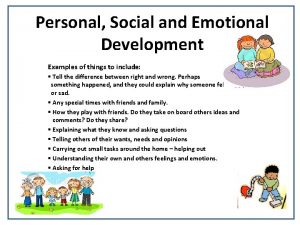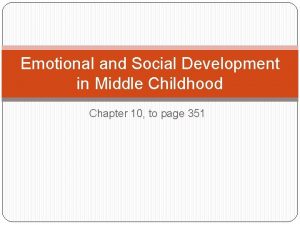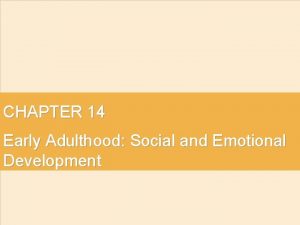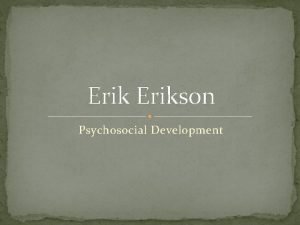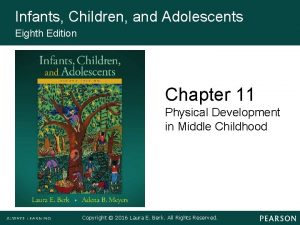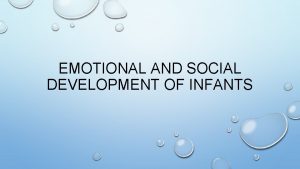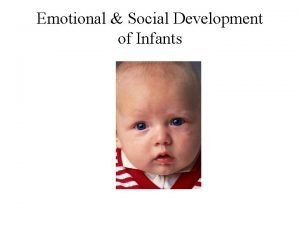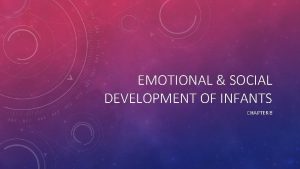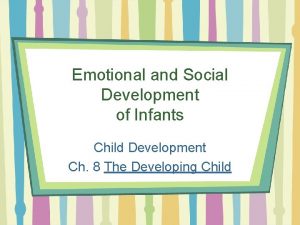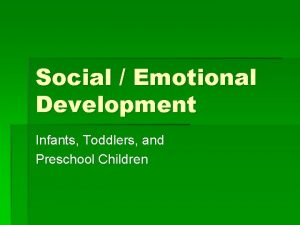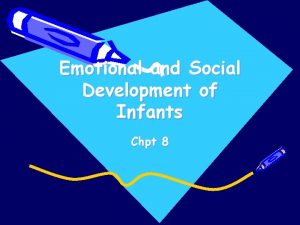Emotional and Social Development of Infants Emotional Development










- Slides: 10

Emotional and Social Development of Infants

Emotional Development • Emotional development is the process of learning to recognize and express one’s feelings and to establish one’s identity as a unique person. • A child with healthy emotional development becomes an adult with self-confidence, can handle stress and shows empathy toward others.

Social Development • Social development is the process of learning to interact with others and to express oneself to others. • Healthy social development results in an adult who shows tolerance for others, can communicate well and listens to other points of view before acting.

Attachment • Attachment is a bond between parent and child gained through physical contact. • Babies have a basic need for physical contact including being: – Held – Cuddled – Rocked

Failure to Thrive • A lack of love and attention may result in a baby’s failure to thrive or marasmus. This is a condition in which the baby does not grow and develop properly. • If these babies are not helped, they will become unattached. As adults they will be unable to develop caring, meaningful relationships with others.

Baby’s Temperament • A baby’s temperament is his or her style of reacting to the world and relating to others. • There are 9 different ways of looking at a baby’s temperament: • Intensity—how strong or weak a child’s emotional response is to events or other people • Persistence—how determined a child is to complete an activity • Sensitivity—How strong the reaction is to the baby’s feelings

Baby’s Temperament Continued • Perceptiveness—how aware the child is of his or her surroundings • Adaptability—the child’s ability to adjust to changes • Regularity—whether or not the child follows the same pattern each day • Energy—how physically active a child is • First Reaction—how a child faces a new situation • Mood—is child generally cheerful or cranky?

Why do Babies Cry? • Babies cry to communicate. Usually when a baby cries, it is because he or she is hungry, tired, needs a diaper change or to burp, is too hot or cold or wants human contact. • To comfort a baby, try: – Holding or rocking the baby – Moving the baby to a different position – Softly talking or singing to the baby – Offering a new toy to distract them – Giving them a pacifier to suck on—babies find this comforting

Other Reasons Babies Cry • Colic—this is when a baby is extremely fussy every day. This usually happens in the evening and nighttime and is worst at about 6 weeks of age. • Stranger Anxiety—this is a fear of unfamiliar people which develops around 8 months of age.

Social Development by Month 1 month old—baby responds to calming voice or tender touch 2 months old—baby smiles 3 months old—baby looks at whoever is talking 4 months old—baby laughs 5 months old—baby babbles and doesn’t like to be alone 6 months old—baby likes to play peek-a-boo 7 months old—baby prefers parents and siblings over others 8 months old—baby may crawl room to room looking for company • 9 -10 months old—baby loves attention and playing with others • 11 -12 months old—baby is sensitive to the emotions of others and generally tolerant of strangers • •
 Personality development in infants
Personality development in infants Intellectual development of infants chapter 9
Intellectual development of infants chapter 9 Chapter 7 physical development of infants
Chapter 7 physical development of infants Personal social examples
Personal social examples Middle childhood social and emotional development
Middle childhood social and emotional development Social development for middle adulthood
Social development for middle adulthood Early adulthood emotional development
Early adulthood emotional development Social and emotional development in late adulthood
Social and emotional development in late adulthood Autonomy vs shame and doubt example
Autonomy vs shame and doubt example Gains in perspective taking permit the transition to
Gains in perspective taking permit the transition to Berk 8th edition
Berk 8th edition


